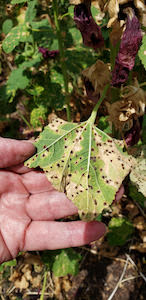 Undersides of these hollyhock leaves are covered with rust pustules. Photo credits Eileen R.Question: What’s causing this rash of dark brown fuzzy spots on the undersides of my hollyhock leaves, and is it killing my plants?
Undersides of these hollyhock leaves are covered with rust pustules. Photo credits Eileen R.Question: What’s causing this rash of dark brown fuzzy spots on the undersides of my hollyhock leaves, and is it killing my plants?
- Eileen R., Las Cruces
Answer: I immediately knew what you’re describing because we found these alarming spots on the undersides of scarlet globemallow leaves here at the NMSU Agricultural Science Center at Los Lunas this May. We identified them as symptoms of mallow rust with the help of the NMSU Plant Diagnostic Clinic (PDC) in Las Cruces (https://aces.nmsu.edu/ces/plantclinic/). A native wildflower, scarlet globemallow is a member of the mallow (Malvaceae) plant family, and guess what? So are hollyhocks.
Mallow rust (Puccinia malvacearum), also known as hollyhock rust, is a species of fungus that commonly attacks plants in the mallow family. There are thousands of other Puccinia fungi that infect other species, and there are many, many other genera of rust fungi (like Phragmidium spp. that affect species in the rose family). Samples that have been positively identified by the PDC as having one type of rust or another include leaves of corn from Chaves County, turfgrass and periwinkle from Bernalillo County, cotton from Doña Ana County, roses from Los Alamos County, sunflowers from Sandoval County, and asparagus stems as recently as June of this year from Valencia County.
Phillip Lujan, Diagnostician for the PDC, offered suggestions for what we might do about the rust on scarlet globemallow plants, which are planted in research plots for a pollinator study: “When you start seeing those spots darken, the fungal spores have likely already been released, so removing leaves may not be necessary. If you want to catch it before it spreads, you'll have to check your plants early and often. Look for raised bumps on the undersides of the leaves and remove affected leaves using clippers. Be sure to disinfect tools between cuts with ethanol or 70% isopropyl alcohol to prevent further spreading.”
Depending on the circumstances, infection with a rust fungus may just show up on the older, lower leaves and stay put, like it did on our scarlet globemallows, which now look great almost 2 months later. In other situations, particularly with increased rainfall, this pathogen can wreak havoc and cause problems. We can blame it on the rain, so to speak, but we all know every drop is worth it. While we can’t slow the rain, many cultural and environmental practices can be altered to reduce the chances of rust getting out of control on our landscape ornamentals. Fungicide treatments can help, but before you go there, consider spacing plants a little farther apart or thinning them when the hollyhock clusters get too thick. Airflow between and around leaves helps them dry out between showers and lowers fungal vigor.
Avoid sprinkling aboveground plant parts with water, both because watering leaves and stems encourages fungal organisms and because it’s wasteful. Applying water to the root zone in the soil is the best way to irrigate. Watering susceptible plants in the morning, so the surrounding air dries more quickly, is another easy strategy. Collecting and removing leafy debris in the fall can help reduce next year’s outbreak intensity.
I understand why Eileen described the leaf spots as looking like a rash. These fungal spore masses are called pustules. They range in color from yellow to orange to reddish-brown to black and often have a velvety look, hence the description of them being fuzzy. These pustules—sorry to keep using that term, but it’s the formal vernacular—usually form on the undersides of leaves or along stems, but sometimes they’re also found on the leaf surfaces. On our scarlet globemallow, the affected leaves twisted and practically flipped over, making it look like the pustules were on the leaf surface. A term for leaf bending and flipping is epinasty. Let’s save epinasty for another column and get back to the pustules. When identifying rust on your plants, look for pale yellowish spots on leaf surfaces, and then gasp like I did when you flip the leaf over and see all the fuzzy pustules.
Visit the blog version of this week’s column to find links to several NMSU Extension Guides dealing with rust on cotton plants, turfgrass, and other ornamentals (https://nmsudesertblooms.blogspot.com/) and photos galore.
Send gardening questions to Southwest Yard and Garden - Attn: Dr. Marisa Thompson at desertblooms@nmsu.edu.
Please copy your County Extension Agent and indicate your county of residence when you submit your question!
For more gardening information, visit the NMSU Extension Horticulture page at Desert Blooms.